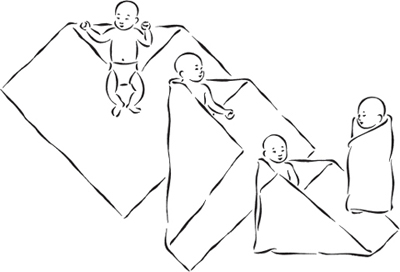7. Dressing Your Baby
One of the most challenging
tasks for a new parent is dressing baby. It’s not like dressing a baby
doll—baby dolls don’t wiggle and squirm! But there are a few tricks we
can pass along to help make your first attempts a little easier. Our
best advice is to take it slow, and don’t get frustrated. With
practice, you’ll soon be an expert!
Some tips we’ve learned over the years
deal with the types of clothing you choose for baby. If you use
T-shirts with a snap bottom, it’ll be a snap to get them on! In
addition, you won’t find baby nearly engulfed in his T-shirt because it
won’t ride up his chest when he squirms or rolls around. A snap-bottom
shirt helps keep his diaper in place. A one-sie with feet is the
easiest outfit to put on and take off. It may be the perfect outfit for
Dad to start with.
After you’ve diapered baby, put on his
undershirt. Hold the shirt neck open with your fingers, and slip it
over his head. Reach into the end of one sleeve, grasp his hand and
gently pull it through. Adjust the body of the shirt once you’ve got
both arms in. When you put his pants on, first reach through the bottom
leg opening and grasp one foot. Slide it through the opening, then do
the same for his other foot. Once both feet are through the leg
openings, pull pants up to his waist.
If you’re putting on overalls, we’ve
found sliding them on from the bottom works best. Adjust them, snap the
legs, then hook the straps. With a sleeper or one-piece outfit that
opens down the front, lay it down on the changing table, then lay baby
on top of it. Slide baby’s arms, one at a time, through the sleeves,
adjust, then slip baby’s feet through the openings. When everything’s
in place, snap the snaps or zip up.
A word of advice: When changing your newborn, keep the room warm. A small baby can get cold quite quickly when undressed.
8. Swaddling Your Infant
Before her birth, your baby was in a
pretty tight environment, with little room to move. When she’s born,
the lack of confinement may make her feel a little insecure. Swaddling,
wrapping her snugly in a soft blanket, can help if she seems
discontented. It can help make her feel secure and comfort her. In
fact, research shows that swaddled babies (under 3 months of age) are
less restless and don’t startle as easily as babies who are not
swaddled. Swaddling also helps a baby sleep well on her back. She may
wake up less often and sleep longer when she is swaddled.
Lay a blanket (a square receiving blanket
works well) on a flat surface in a diamond shape. You can fold the top
down inside or leave it up, if it’s cold and you want to protect baby’s
head. You may want to use a “swaddling blanket,” a special blanket
designed to swaddle baby. Many different types are available. Check
local stores or the Internet if you are interested.
Place baby on the blanket, with her head
at the top of the diamond, and place her arms by her face or her side.
Some babies are comforted when their hands are left by their faces—this
is often the case with a premature baby.
Fold the top-left edge of the blanket
across her body, pulling it taut. Tuck excess material under her back.
Bring the bottom corner of the blanket up over her body. Some babies
like their legs tucked into a fetal position; others don’t. Fold the
top-right edge of the blanket across her body, and tuck excess material
under her back. She can be laid in her crib in this manner, or you can
hold her. Be sure you don’t swaddle her so tightly that it affects her
breathing.

Wrap baby snugly in a
blanket to comfort her; arms
may be wrapped or left free.